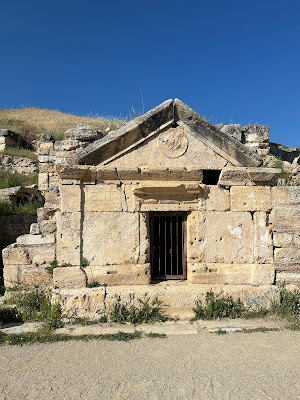Church history associates the Apostle Philip with Hierapolis.
You might not remember Philip so much; he is one of the "not in the inner circle" apostles. He does come up from time to time though, mostly in the Gospel of John. He is the one that asks Christ how they will feed the 5,000. He is the one that the Greek speakers came to in order to meet Christ (along with his name, likely suggesting he spoke Greek as well as Aramaic). He is the one at the last Supper that asks Christ to show them the Father.
Church tradition holds that he preached in Galilee, Greece, Parthia, and finally in the Roman province of Asia in Phyrigia, where he last settled in Hierapolis. He was martyred - traditionally by being crucified upside down, but beheading is also not out of the question - on or about A.D. 80.
Around A.D. 2011, a site that had been long associated with him was determined to be the original resting place of his relics (which were transported long ago to Rome).
The church, a martyrion (or martyrium), is simply a church built over the tomb of the martyr. It is located outside the city walls - not surprising, as few citizens were buried within the city walls.
The hike itself from Hierapolis proper was pleasant enough, a gentle rise that gets one a view over the whole valley.





















Interesting to find out more about the man and to walk where he walked TB. You had some sunny days on that trip eh?
ReplyDeleteNylon12, I had not associated any apostle with Hierapolis (everyone knows the places Paul wrote his letters to, of course) until I got there. I will say that seeing more of the Biblical sites both here and in Greece has given me a greater appreciation for their travels and trials. Travel in the modern world is an inconvenience; imagine getting from Jerusalem to the lower middle of Anatolia on foot or by ship, literally separated from everything and everyone you knew.
DeleteWe had splendid weather there, although this was one of the hotter days we experienced.
Many years ago, I read a book about the apostles that focused mainly on their deaths and what became of their bodies. It was a fascinating read and a reminder that there was a lot of risk associated with being an apostle.
ReplyDeleteEd, Eusebius' Ecclesiastical History (that I recall) and Foxe's Book of Martyrs both touch on the end of all of the apostles. It is probably a good thing for me to revisit that - they literally just kept going and going farther and farther out until they were all finally killed (except for John, of course, who lived to a ripe old age).
DeleteInteresting bit of church history, TB. When I think of early Christians, I don't picture them meeting in churches, but rather in homes. I'm suddenly wondering how early were the earliest church structures (for Christian worship) built. I'm not sure I have the stick-to-itiveness to do it for very long, but I have an itch now to do a bit of research on this when reading scriptures addressing different churches. I'm assuming in the time that new testament scriptures were written, Christians weren't yet worshipping in structures dedicated to worship, or would some have been? You've made me curious.
ReplyDeleteBecki - I think at the time of the Apostles no, Christians would not have been worshipping in formal "churches". This would have very much been personal homes. Perhaps some more formal buildings might have been used at those time - we read that Paul taught in the school of Tyrannus, and preached in more than one synagogue, but a public building would have been liable to destruction by the various waves of persecution.
DeleteMy guess in this case is that the tomb of Philip was known, and eventually the church sprang up there, similar to St. Peter's or the Church of The Holy Sepulcher.
I didn't know anything about Philip, so this was interesting. Hierapolis now looks like a very lonely place. Turkey has so many historical ruins, I'm guessing refurbishing dollars will never be enough to address all of them.
ReplyDeleteLeigh, doing a bit of reminder reading for myself for this post, I was surprised by how much we have of Philip (versus some of the other apostles not named Peter, James, or John).
DeleteIt would be a huge task. Even now, the various sites are managed from an archaeological perspective by various universities outside of Turkey - for example, Hierapolis is operated (in archaeological terms) by The Italian Archaeological Mission of Frigia. Many of the sites have similar relationships based on history (for example, several German site managements, the U.S. Archaeological Mission in Athens that rebuilt the Stoa of Attalos, etc.)